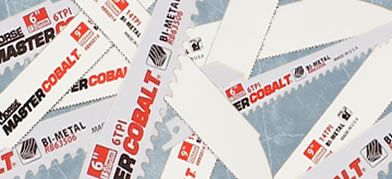Reciprocating Saw Blade Glossary of Terms
- HCS
- High Carbon Steel - the softest of the blade materials. HCS blades are flexible to allow bending without breaking, which also makes them the least durable. They are best suited to cutting softer materials.
- HSS
- High Speed Steel - subjected to a tempering process that makes them more heat-resistant and durable. They last up to 5 times longer than HCS blades.
- Bi-Metal
- Combination of a high-carbon steel body for flexibility and break-resistance, and high-speed steel or cobalt-steel alloy cutting edge for heat-resistance, hardness, and durability.
- Carbide Tip
- Bi-metal blades with a carbide (tungsten carbide or titanium carbide) tip at the end of each tooth. Carbide materials are extremely hard, heat-resistant, and impact-resistant. They are used to cut thicker pieces of metal including cast iron, stainless steel, and high-strength alloys.
- Carbide Grit
- Blades with an abrasive strip of tungsten carbide grit instead of metal teeth. These blades are often used for cutting dense materials such as ceramic tile, cement, brick, stone, and masonry.
- Diamond Grit
- Blades with an abrasive strip of diamond grit instead of metal teeth. They are used to cut concrete, glass, fiberglass, and ceramic, and can also cut fiber cement, cast iron, and masonry.
- TPI
- Teeth Per Inch
- Kerf
- Also listed as "kerf width", this is the width of the cut made by the blade. It is determined by the tooth set and width.
- Gullet
- The spacing between the blade's teeth. Since the gullet size determines the amount of material removal, it is typically proportional to the tooth size. In general, as the number of teeth per inch increases, the tooth size decreases. Therefore the gullet size also decreases because less material must be removed per blade pass.
- Tooth Set
- The configuration of the teeth on a saw blade.
- Raker Set
- A repeating 3 tooth pattern consisting of one tooth that is angled outward to the right, another to the left, and the third tooth straight. These blades are more aggressive, have a wider kerf, and cut faster than wavy set teeth. They are better for contour cutting, wood, and framing.
- Wavy Set
- A consistent tooth pattern with a groups of teeth set to one side or the other, separated by a group of unset teeth. If you look at the bottom of the blade with the teeth facing you, they would appear in a wavy pattern. Wavy set blades are suitable for use in all types of materials and have a smaller kerf width than raker set teeth.
- Variable Pitch
- "Pitch" is another way of saying teeth per inch. Variable pitch simply means a variable number of teeth per inch, such as those found in wood/metal combination blades and some demolition blades.
- Hook Angle
- The angle of the blade's teeth relative to the horizontal position of the blade.
- Pocket Cut
- Cutting a shape out of your material, usually a rectangle or circle, and often starting with a plunge cut.
- Plunge Cut
- A slot cut directly into the material - not from the edge - without drilling a pilot hole.
Shop All Blades

